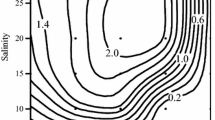Abstract
Anemonia sulcata Pennant absorbs and accumulates tritiated D-glucose dissolved in sea water in natural concentrations (80 μg/l). The rate of decrease of glucose concentration in the sea water can best be described by an exponential function, when the concentration of added glucose exceeds 20 to 25 μg/l. The glucose, absorbed through the ectoderm, is immediately metabolized. This is determinable experimentally by tritiated water which is emitted into the sea water. The rate of uptake estimated experimentally was in the range 3 to 4 μg glucose/g wet weight/h, whilst the rate calculated by V max (maximum absorption rate) was 20 μg/g wet weight/h. The concentration of free glucose in the tentacle tissue is greater by a factor of 105 than that of the medium in which absorption takes place. Absorption is temperature-dependent; the Q10 between 15° and 25°C exceeds 2; translocation is, therefore, energy-dependent. Absorption was diminished by inhibitors, especially by phlorizin. The actinians increase their energy reserves by absorption of glucose (and other dissolved organic substances). The energetic net profit by taking up glucose comprises up to 50% of the energy amount which is equivalent to the oxygen consumption.
Similar content being viewed by others
Zitierte Literatur
Brafield, A.E. and G. Chapman: The oxygen consumption of Pennatula rubra Ellis and some other anthozoans. Z. vergl. Physiol. 50, 363–370 (1965)
Brown, A.C. and G. Brengelmann: Energy metabolism. In: Physiology and biophysics, pp 1030–1047. Ed. by T.C. Ruch and M.D. Patton. Philadelphia-London: Saunders 1966
Fox, F.: The structure of cell membranes. Scient. Am. 226, 30–47 (1972)
Harris, B.G. and C.P. Read: Studies on membrane transport. III. Further characterization of amino acid systems in Hymenolepis diminuta (Cestoda). Comp. Biochem. Physiol. 26, 545–552 (1968)
Kimmich, G.A.: Active sugar accumulation by isolated intestinal epithelial cells. A new model for sodium-dependent metabolite transport. Biochemistry, N.Y. 9, 3669–3677 (1970)
Läuger, P.: Molekulare Mechanismen des Transports durch biologische Membranen. Verh. dt. zool. Ges. 65, 157–164 (1972)
Lehniger, A.: Bioenergetik., 220 pp. Stuttgart: Thieme 1970
Pütter, A.: Der Stoffwechsel der Aktinien. Z. allg. Physiol. 12, 297–322 (1911)
Randerath, K.: Dünnschicht-Chromatographie, 291 pp. Weinheim/Bergstr: Verlag Chemie 1965
Riley, J.P. and R. Chester: Introduction to marine chemistry, 465 pp. London & New York: Academic Press 1971
Ring, K.: Einige Aspekte des aktiven Aminosäurentransports. Angew. Chem. 82, 343–355 (1970)
Schlichter, D.: Aktinien nehmen Aminosäuren und Glucose aus dem Meerwasser auf. Natuwissenschaften 58, 455–456 (1971)
—: Ernährungsphysiologische und ökologische Aspekte der Aufnahme in Meerwasser gelöster Aminosäuren durch Anemonia sulcata (Coelenterata, Anthozoa). Oecologia (Berl.) 11, 315–350 (1973)
—: Meerwasser als Nahrungsquelle: Die Aufnahme gelöster organischer Verbindungen durch marine Organismen. Verh. Ges. Ökol. Saarbrücken 1973 (3. Jversamml.), 25–38 (1974a)
—: Der Eihfluß physikalischer und chemischer Faktoren auf die Aufnahme in Meerwasser gelöster Aminosäuren durch Aktinien. Mar. Biol. 25, 279–290 (1974b)
—: Aufnanme in Meerwasser gelöster Aminosäuren durch Anemonia sulcata Pennant. Das unterschiedliche Resorptionsvermögen von Ekto-und Entoderm. Z. Morph. Tiere 79, 65–74 (1974c)
Schultz S.G. and P.F. Curran: Coupled transport of sodium and organic solutes. Physiol. Rev. 50, 637–718 (1970)
Stephens, G.C.: Uptake of organic material by aquatic invertebrates. I. Uptake of glucose by the solitary coral, Fungia scutaria. Biol. Bull. mar. biol. Lab., Woods Hole 123, 648–659 (1962)
—: Dissolved organic material as a nutritional source for marine and estuarine invertebrates. In: Estuaries, pp 367–373. Ed. by G.H. Lauff. Washington: American Association for the Advancement of Science 1967
—: Dissolved organic matter as a potential source of nutrition for marine organisms. Am. Zool. 8, 95–106 (1968)
Tait, R.V.: Meeresökologie, 305 pp. Stuttgart: Thieme 1971
Taylor, A.G.: The direct uptake of amino acids and other small molecules from sea water by Nereis virens. Comp. Biochem. Physiol. 29, 243–250 (1969)
Testerman, J.K.: Accumulation of free fatty acids from sea water by marine invertebrates. Biol. Bull. mar. biol. Lab., Woods Hole 142, 160–177 (1972)
Vaccaro, R.F., S.E. Hicks, H.W. Jannasch und F.G. Carey: The occurrence and role of glucose in seawater. Limnol. Oceanogr. 356–360 (1968)
Wagner, F.S. Jr.: Composition of the dissolved organic compounds in seawater: a review. Contr. mar. Sci. 14, 115–153 (1969)
Author information
Authors and Affiliations
Additional information
Communicated by O. Kinne, Hamburg
Rights and permissions
About this article
Cite this article
Schlichter, D. Die Bedeutung in Meerwasser gelöster Glucose für die Ernährung von Anemonia sulcata (Coelenterata: Anthozoa). Mar. Biol. 29, 283–293 (1975). https://doi.org/10.1007/BF00388848
Accepted:
Issue Date:
DOI: https://doi.org/10.1007/BF00388848




